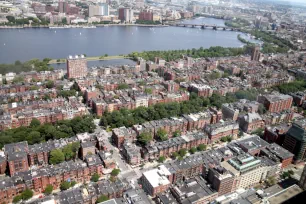The construction in the early nineteenth century of the Mill Dam and Cross Dam west of Beacon Hill caused the creation of a large swamp. It was considered a health hazard and the filling of the swamp was started in 1857.

This project, which took almost thirty years to complete, was the start of a new popular district: Back Bay.
A New District



The plan by the architect Arthur Gilman was approved in 1856. It is based on the French model and has a strict street grid, unique for Boston at the time. The mostly three to four-story brownstone houses were designed by different architects, but thanks to the strict regulations, they all integrate nicely. The houses had every amenity and were of high quality. It attracted many rich Bostonians who moved from the South End or Beacon Hill to this new fashionable district. Even today, Back Bay is a popular and wealthy district.
Historic Streets
Some houses have not survived the demolition frenzy of the seventies, but overall the district has survived relatively unscathed.
The most interesting streets in the neighborhood are Newbury Street and Commonwealth Avenue. Newbury is a very attractive, European-style shopping street where you can buy the latest fashion or have lunch in a trendy café. Commonwealth Avenue, a.k.a. ‘Comm. Ave.’ is a Parisian-style wide boulevard with expensive townhouses.
Copley Square
Copley Square is the district’s small, but prominent central square. Despite its lack of size, it boasts several landmarks: among the most famous are the 1877 Trinity Church, the 1895 Public Library and the 1975 John Hancock Tower.

